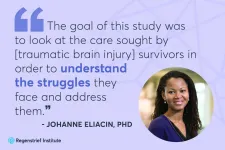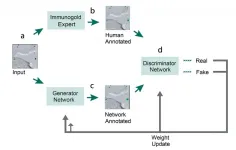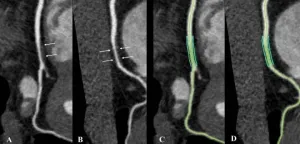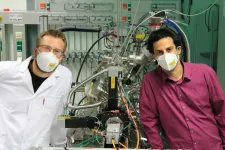(Press-News.org) INDIANAPOLIS -- Patients who suffer from traumatic brain injuries (TBI) often need a great deal of healthcare services after the injury, but the extent of care utilization is unknown. A new study from research scientists affiliated with the U.S. Department of Veterans Affairs (VA), Regenstrief Institute and IUPUI is one of the first to analyze how much care TBI patients use and identify areas of unmet need.
"There is not a lot of information about traumatic brain injury care utilization available," said primary study author Johanne Eliacin, PhD, a Regenstrief research scientist and core investigator at the VA Health Services Research and Development Center for Health Information at Richard L. Roudebush VA Medical Center. "In fact, until a few years ago, TBI was viewed as a one-time event. The goal of this study was to look at the care sought by survivors in order to understand the struggles they face and address them."
The study used the Indiana TBI registry for its cohort. The registry, funded by the Indiana Department of Health, contains all individuals diagnosed with mild, moderate and severe TBI listed in the Indiana Network for Patient Care (INPC), which is managed by Indiana Health Information Exchange. The research team looked at patients who were hospitalized with a TBI from 2005 through 2014 and examined healthcare utilization data for one year after the TBI event. That data was broken down into three categories: emergency department, inpatient and outpatient care.
Researchers found that many TBI survivors needed extensive healthcare services in the year after their injury, and a quarter of them were super-utilizers, having three or more emergency department visits or inpatient encounters or more than 26 outpatient visits during the year.
The results indicate that health insurance impacted the amount and type of care utilized, as did race, gender and residency status. Study authors say these potential disparities are an important area to focus on in future research.
"Because this is one of the first studies looking at these data, we are just beginning to identify patterns," said Dr. Eliacin. "More work is needed to dig into the social determinants of health that impact a TBI survivor's outcomes and to understand the struggles faced by those who are high utilizers of the healthcare system."
A previous qualitative study published by Dr. Eliacin presented some of the challenges patients and caregivers reported, which included the struggle to understand what care was available and where to access it.
"The Indiana TBI registry is an important resource to be able to understand the healthcare journeys of TBI patients," said study author Brian Dixon, PhD, MPA, Regenstrief and Indiana University Richard M. Fairbanks School of Public Health at IUPUI director of public health informatics. "We can leverage these data to identify population needs and develop interventions to improve quality of life as well as the access to and utility of their care."
"Characterizing health care utilization following hospitalization for a traumatic brain injury: a retrospective cohort study" was published in the journal Brain Injury.
In addition to Drs. Eliacin and Dixon, authors on the paper are Ziyi Yang, M.S. of IUPUI and Jacob Kean, PhD, of the VA Salt Lake City Health Care System and the University of Utah School of Medicine.
This work was supported, in part, by the Indiana Spinal Cord & Brain Injury Research Fund from the Indiana Department of Health. It was also supported by a VA Rehabilitation Research and Development Career Development Award IK2RX000879 to Dr. Kean.
IHIE is a non-profit, software development organization that operates the INPC -- the nation's largest inter-organizational clinical data repository which houses more than 14 billion pieces of patient data from 95% of Indiana.
INFORMATION:
About Regenstrief Institute
Founded in 1969 in Indianapolis, the Regenstrief Institute is a local, national and global leader dedicated to a world where better information empowers people to end disease and realize true health. A key research partner to Indiana University, Regenstrief and its research scientists are responsible for a growing number of major healthcare innovations and studies. Examples range from the development of global health information technology standards that enable the use and interoperability of electronic health records to improving patient-physician communications, to creating models of care that inform practice and improve the lives of patients around the globe.
Sam Regenstrief, a nationally successful entrepreneur from Connersville, Indiana, founded the institute with the goal of making healthcare more efficient and accessible for everyone. His vision continues to guide the institute's research mission.
About the VA Health Services Research and Development Center for Health Information and Communication
The Health Services Research and Development (HSR&D) Center for Health Information and Communication (CHIC) group is a diverse cadre of researchers joining together to transform the healthcare system, both within and outside the VA so every patient receives consistent, high-quality care.
About IUPUI
As Indiana's premier urban public research university, IUPUI believes in the power of transformation. It is committed to providing educational opportunities that transform the lives of students, the community, and the changing world. It offers more than 450 undergraduate, graduate and professional programs from Indiana University and Purdue University.
About the Richard M. Fairbanks School of Public Health at IUPUI
Located on Indiana's premier research and health sciences campus, the Richard M. Fairbanks School of Public Health at IUPUI is committed to advancing the public's health and well-being through education, innovation and leadership. The Fairbanks School of Public Health is known for its expertise in biostatistics, epidemiology, cancer research, community health, environmental public health, global health, health policy and health services administration.
About Johanne Eliacin, PhD
In addition to being a research scientist at Regenstrief Institute, Johanne Eliacin, PhD, is a core investigator at the U.S. Department of Veterans Affairs Health Services Research and Development Center for Health Information and Communication, Richard L. Roudebush VA Medical Center. She is also a research scientist at the Indiana Alzheimer's Disease Research Center.
About Brian E. Dixon, Ph.D., MPA
In addition to his role as Regenstrief Institute and Indiana University Richard M. Fairbanks School of Public Health at IUPUI director of public health informatics, Brian E. Dixon, MPA, PhD, is a research scientist at Regenstrief and an associate professor of epidemiology at the Fairbanks School of Public Health. He is also an affiliate scientist at the U.S. Department of Veterans Affairs Health Services Research and Development Center for Health Information and Communication, Richard L. Roudebush VA Medical Center.
A recent study suggests that preserving physical and mental health helps older adults experiencing cognitive impairment stave off declines in cognitive engagement.
"We found that declines in physical and mental health were associated with more pronounced cognitive disengagement," says Shevaun Neupert, corresponding author of the study and a professor of psychology at North Carolina State University. "The impact of declines in physical health was particularly pronounced for study participants who had more advanced cognitive impairment to begin with."
There's ...
With roughly 80% of jobs being sedentary, often requiring several hours of sitting stooped in front of a computer screen, neck pain is a growing occupational hazard. Smartphones and other devices have also caused people to bend their necks for prolonged periods. But is bad posture solely to blame?
In a recent study, researchers at Texas A&M University have found that while poor neck and head postures are indeed the primary determinants of neck pain, body mass index, age and the time of the day also influence the neck's ability to perform sustained or repeated movements.
"Neck pain is one of the leading and fastest-growing ...
UNIVERSITY PARK, Pa. -- Have you recently turned to your mobile device or computer to find out if your cough, sniffle or fever could be caused by COVID-19?
The online symptom checker you used may have advised you to stay home and call your medical provider if symptoms worsen, or perhaps told you that you may be eligible for COVID-19 testing. But why did it make the recommendation it did? And how should you know if you can trust it?
Those are questions that researchers at the Penn State College of Information Sciences and Technology recently explored through a project in which they augmented online symptom checkers by offering explanations of how the system generated its probable diagnoses and suggestions ...
From sample preparation to image acquisition, electron microscopy (EM) requires precise and time-consuming steps to produce the clarity and detail needed to visualize small cell structures with high resolution. Moreover, once EM images are created, extracting the biological information out of them through analysis can be an even more laborious and time intensive task. Especially because current EM analysis software often requires the skilled eye of a scientist to manually review hundreds of images.
With a bit of ingenuity and the application of cutting-edge neural networks, an interdisciplinary team of scientists at the Max Planck Florida Institute for Neuroscience (MPFI) have created a new ...
OAK BROOK, Ill. - People living with human immunodeficiency virus (HIV) and without known cardiovascular disease have two to three times the noncalcified coronary plaque burden of non-HIV healthy volunteers, according to a study from Canada published in Radiology. Researchers said the results underscore the importance of a heart-healthy lifestyle in people living with HIV.
HIV/AIDS emerged as a major public health crisis in the 1980s. Disease-related mortality peaked in the mid-1990s and has been dropping since, thanks in large part to antiretroviral therapy, which does not cure the disease but helps control it.
Today, people ...
Researchers at Beam Therapeutics have developed a redesigned base editor that shows considerable promise in directly repairing the single-base mutation that causes sickle-cell disease (SCD). Many strategies are being pursued to harness genome editing approaches including CRISPR to treat patients with SCD and related hemoglobinopathies. The most advanced method in the clinic involves targeting an upstream regulatory pathway to switch on expression of the fetal hemoglobin gene but does not target the SCD mutation directly.
Writing in the April issue of The CRISPR Journal, a team at Beam Therapeutics, led by Ian Slaymaker and Giuseppe Ciaramella, describe the successful ...
In a study conducted at the University of Helsinki, researchers found a cause for severe epilepsy resulting in death in Parson Russell Terrier puppies at a few months of age. A change in the PITRM1 gene can lead to a dysfunction of mitochondria, the cellular energy pumps. Concurrently, amyloid-β accumulation and widespread neurodegeneration associated with Alzheimer's disease were identified in the puppies' brains. Changes to the PITRM1 gene in humans also cause a severe but slowly progressing brain disease.
Some Parson Russell Terrier puppies were seen to suddenly develop epileptic seizures at 6 to 12 weeks of age. The disease progressed very rapidly, in a matter of hours in the worst cases, to a situation where the seizures were continuous and unresponsive to medication.
"All ...
Exposure to certain endocrine-disrupting chemicals could elevate the risk of breast cancer, according to a new comprehensive systematic review of epidemiological research. However, for many chemicals, evidence is inconsistent or still limited. The review was carried out by researchers at the universities of Hong Kong and Eastern Finland and published in Critical Reviews in Food Science and Nutrition.
Endocrine-disrupting chemicals (EDCs) can interfere with the body's hormonal system, also called the endocrine system, and are widely present in the environment. They originate from a variety of ...
If the CO2 content of the atmosphere is not to increase any further, carbon dioxide must be converted into something else. However, as CO2 is a very stable molecule, this can only be done with the help of special catalysts. The main problem with such catalysts has so far been their lack of stability: after a certain time, many materials lose their catalytic properties.
At TU Wien, research is being conducted on a special class of minerals - the perovskites, which have so far been used for solar cells, as anode materials or electronic components rather than for their catalytic properties. Now scientists at TU Wien have succeeded in producing a special perovskite that is excellently suited as ...
As we accumulate more and more gene-sequencing information, cell-type databases are growing in both size and complexity. There is a need to understand where different types of cells are located in the body, and to map their gene expression patterns into specific locations in tissues and organs. For example, a gene can be actively expressed in one cell while suppressed in another.
One way of mapping genes into tissues is a technique called in situ hybridization. Simply put, a target gene is tagged ("hybridized") with a fluorescent marker within the sections of the tissue it is located in (the "in situ" part). The sections are then visualized under a specialized microscope to see where the gene "lights up". Consecutive photographs of each section are then put together to generate a ...



